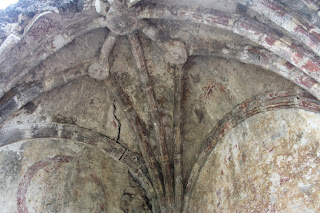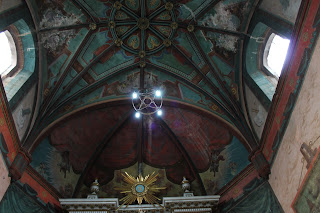45 minutes due north from where we live is a town called Tepotzotlán, where the Jesuits established a school at the beginning of the 17th Century, and which we have written several articles, the last of which was about the marvelous exhibit on Miguel Cabrera, esrlier this year.
Archway leading into atrium of
La Natividad de la Virgen,
Tepoztlan
Today we drove 2 hours, heading in the opposite direction, due south, to a mission with a confusingly similar name, Tepoztlán, a community that was evangelized in the mid 16th century, by the Dominicans, under the leadership of Fray Domingo de la Anunciacion, who dedicated the church in the name of the Natividad de la Virgen, or Nativity of Our Blessed Virgin.
This is the view of the main archway entrance into
the atrium of the Navitidad de Maria Chruch, from
inside the atrium look out. Outside is the city
market.
The walls of the atrium still have the lookout
tower (to the right of the arch) and the defensive wall
of a medieval fortress, a common feature of 16th
monasteries and atriums.
Tepoztlán receives its name in reference to the nearby high-ridge sierra Tepozteca and its mountain-top pyramid, 44 years ago, on a weekend trip we took out of Mexico City to Cuernavaca, I saw the Tepozteco for the first time as we passed by on, and the sight was foreboding.
The neoclassical base of the cross
was built in the 19th century, but
the atrium cross is from the 16th.
As you leave Mexico City from the south, there is no other option than climbing up from the borough of Tlalpan, at an altitude of 2,200 meters above sea level and across the Ajusco Mountain range, past Topilejo, until you come to a point of 3,100 meters above sea level, before we start making a descent down into the central valley of Morelos, at 1,200 meters above sea level.
Estela is in the atrium of the church,
just beneath the Cross. The arms of
the Cross end in the form of the lilies,
symbol of the purity of the Order
of Preachers as the Dominican Order
is also known, and a crown of thorns
in the center with an 8-pointed star
inside.
The highway makes a severe and dangerous 180 degree turn on this descent, at a point known as "La Pera" or pear, and the Tepozteca appears abruptly, in the middle of this plain, clearly an indication of some violent movement of tectonic plates on the lithosphere, millions of years ago.
A legend contends that the a local hero fought against a feathered serpent that swallowed our hero, knife and all. Predictably, the hero cut himself free from the bowels of the legendary monster, using an obsidian knife.
Main Portico or entrance to the
of the Nativity of Our
Blessed Virgin Mary, Tepoztlán,
The above stone door frame was designed and built by a Spanish architect and artist, Francisco Becerra, in 1565. Francisco Becerra was born in Extremadura, Spain. Becerra worked on the Church of Santo Domingo, in downtown, Mexico City, 4 blocks north of the Cathedral, but most of his work was in convents and churches in the City of Puebla, where he became the official municipal "Alarife" (word in Arabic, a term used extensively in Southern Spain, during and after its occupation by the Moors, meaning architect as well as someone in charge of the aesthetic design of a construction).
At the top, two angels flank an inscription that was
never written. In the center, the Blessed Virgin
Mary is flanked by Saint Dominic and Saint
Catherine of Siena
When we see Saint Catherine of Siena, many of us think of her, as a young girl, walking down Via del Costone, coming home from her aunt's house, with her little brother in hand, and imagine her as she has her first vision of Our Lord Jesus Christ and His Heavenly Father, in the sky, above the church of Santo Domingo, in Siena.
Two Ionic columns on each side
of door frame of the Church
Angel with cross on its head
supporting the column of the
stone carved frame of the main
entrance.
Angle perspective of the Church of the Nativity
of Our Blessed Mother from inside the walled
atrium.
One of the two best preserved
"well chapels" or "capillas de
Pozo" (This atrium still has its
four original "capillas").
All four well chapels had Gothic
ribbed vaults
Beautifully carved half Ionic Columns
flank each side of the entrance
of the corner or well chapels of the
atrium
This "Capilla de Pozo" or Corner Chapel of the
Atrium is on the back right hand side as we come
through the main entrance of the atrium. It is
partially in a state of ruins.
A closer view of the ribbed vault of this "Capilla
de Pozo", partially in a state of ruins. We can
barely make out that there was painting on the
walls, and possibly on the ceiling between the
ribs.
Ionic capital of the corner column of the "Capilla
de Pozo" in ruins stands stoically and elegantly
the tests of time and the elements.
This wall is all that remains of this third "Capilla
de Pozo", which is on our right hand side as we
enter into the main gate of the atrium.
The fourth corner or well chapel
(captilla de pozo) of the atrium is
a unique feature of this shrine as
it also serves as an entrance chapel
to the Monastery
Closer look at the side entrance of this very
narrow but elegant corner and entrance chapel.
Closer view of the narrow Gothic ribbed vault of
this unique corner of well chapel.
The Ionic columns are worse for
the weather, but still project an
elegance of age and form.
The corner or well chapel has an
empty niche which probably
occupied with a statue of Our
Lady (with its shell-formed top, a
symbol of purity), in a previous era.
Central nave with baptism fountain
below choir loft in foreground, and
neoclassical altarpiece in apse,

Wall paintings on the sides of
main altar.
Gothic ribbed vault over main altar. It is not usual
to see painting on the ceilings of Gothic ribbed
vaults in Mexico, as we see here.
"This house of the Lord is firmly built" says the
inscription in Latin. Choir loft with organ (not
in use).































Nice post and pictures. The small chapels are posas, meaning pauses, i.e: prayer stations on ceremonial circuits of the church atrium.
ReplyDeletecolonialmexico.blogspot.com